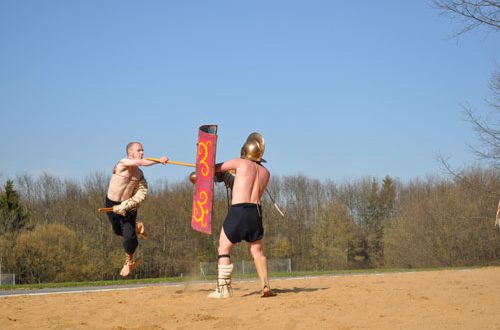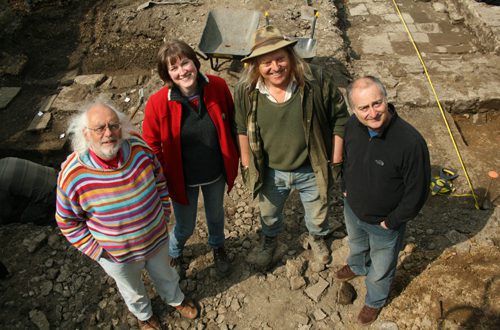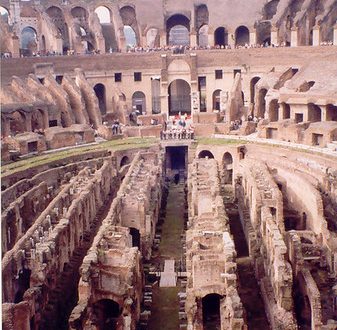
Via Dell’ Impero
An exhibition opening today at the Musei Capitolini in Rome shows the building of the city’s infamous via dei Fori Imperiali (previously via dell’ Impero), which also tore through the forums of Nerva, Augustus and Trajan, with little regard for the ancient Roman constructions that lay beneath.
Via Dell’ Impero – Nascita di una Strada (Birth of a Road) will feature photos, paintings and sketches by professional Roman photographers and artists, including Filippo Reale, Cesare Faraglia and Odoardo Ferretti. The exhibition runs until20 September, documenting the demolition of buildings and the excavations which took place before the via dell’Impero was constructed.
Mussolini’s Rome
In the 1930s, Italy was under the dictatorship of Benito Mussolini, leader of the National Fascist Party. The Fascists took some inspiration from the Roman empire and to a certain extent modelled their large, colonnaded constructions and expansionist ideologies on the civilisation they saw as their political and cultural predecessors. In fact, by 1936 Mussolini was using the title ‘Founder of the Empire’ as part of his official name. It is surprising then, that during the 1930s a strip of land 30 metres wide, between Piazza Venezia and the Colosseum in Rome, was stripped of its buildings (some medieval, many residential) in order to make way for a grand road: one that was worthy of a grand triumph in true Roman style.

Elephants in the Forum?
Also on show are some of the objects found during the excavation work, including marble statues and fragments of painted Roman plaster. While care was taken during the excavation to preserve thousands of these objects, most were stored in crates in the Capitoline Museums and were labelled simply as ‘Via dell’ Impero’, so little further information is available about their exact location of discovery.
Among the more surprising finds during the road’s construction was a prehistoric elephant’s tusk, proving that the Romans, or even the Etruscans (or should that be ‘Etuskans’?) were certainly not the first inhabitants of the Roman Forum.
Rome and Antiquity: A Give-and-Take Relationship
While Mussolini is usually the sole object of blame when lamenting the parts of the Roman Forum lost forever beneath Rome’s busy four-lane road, it is worth pointing out that Il Duce’s desire to ‘improve’ Rome, while giving what we would call insufficient regard to its heritage, was part of a wider movement that started when Italy was unified in around 1871.
At yesterday’s press preview, the museum’s superintendent, Umberto Broccoli, urged the gathering of assorted Italian journalists to see the creation of via dell’ Impero as a continuation of the siege of Rome in 1870, after which Rome and Lazio were annexed to the Italian state. During this siege, the Aurelian walls were bombarded and badly damaged  showing that swathes of modern history will inevitably sweep over the remains of the past and leave their own marks. Following the unification, troops from Piedmont occupied Rome and, once again, the face of the city was changed, with many old buildings being painted in Piedmont’s colours.
showing that swathes of modern history will inevitably sweep over the remains of the past and leave their own marks. Following the unification, troops from Piedmont occupied Rome and, once again, the face of the city was changed, with many old buildings being painted in Piedmont’s colours.
That the politicians, archaeologists and architects of the past century had a different attitude to conserving Rome’s heritage is beyond doubt but,according to Broccoli, the via dell’ Impero was not simply a product of Mussolini’s crass desire to build a grand capital for his very own empire. Rather, it is set in the historical context of about 80 years (from 1870 to the end of the second World War), during which Italy as a nation was establishing its new political identity. This exhibition gives an insight into the construction and excavations of the 1930s, which changed the face of the Roman Forum, as well as modern Rome, forever.
An Aside:
(Insight into the world of Italian press conferences: journalist from a national daily scribbling madly on a leather-bound notebook, looks like a veteran of several Afghan wars but now reporting on the arts in Rome? Lots of elegantly dressed women not taking notes at all, digital cameras flashing and everyone jostling for interviews with the venerable archaeologists present, who have quasi-celebrity status in the world of Italian arts and culture. But who were the elderly couple heckling in the corner?)
All photographs provided from the exhibition, from the Museo di Roma-Archivio Fotografico Comunale.



